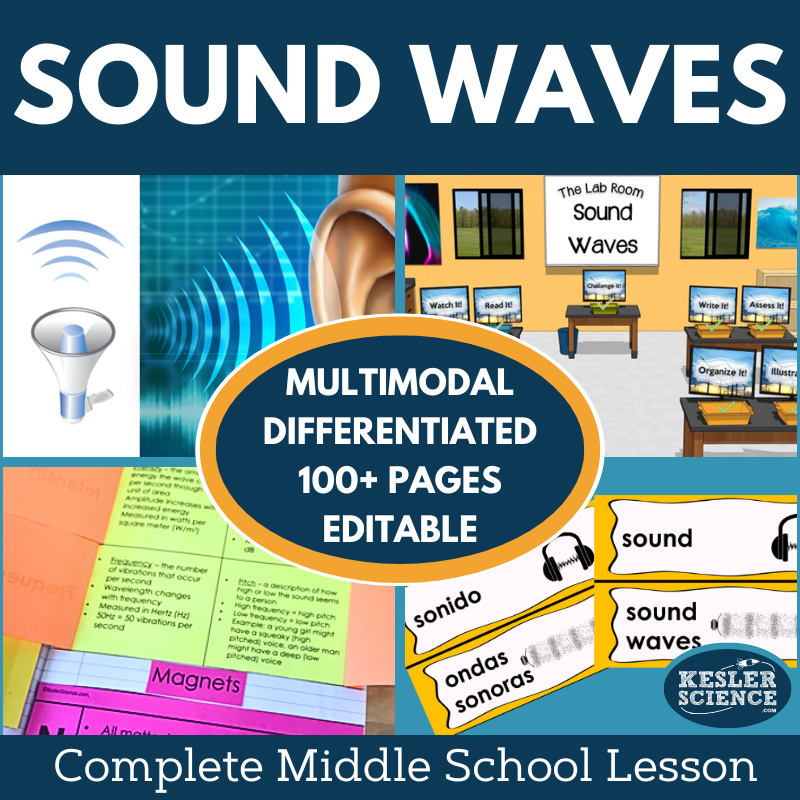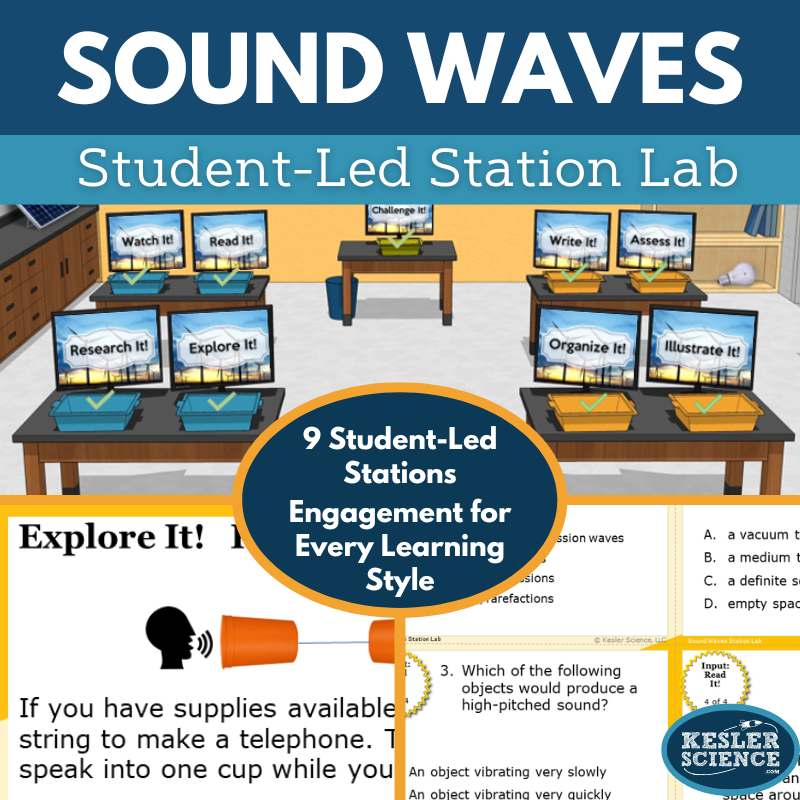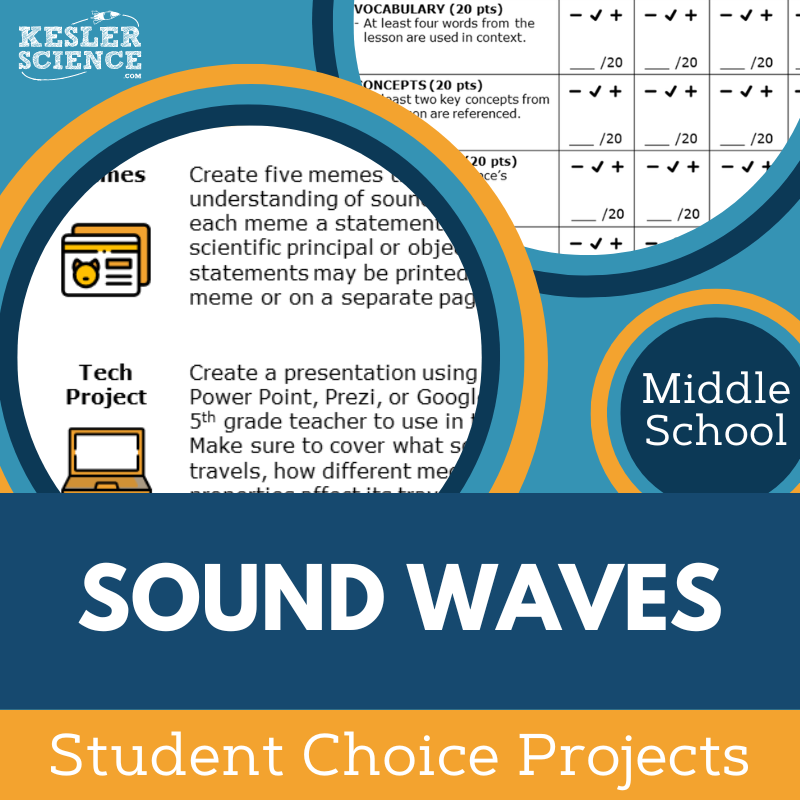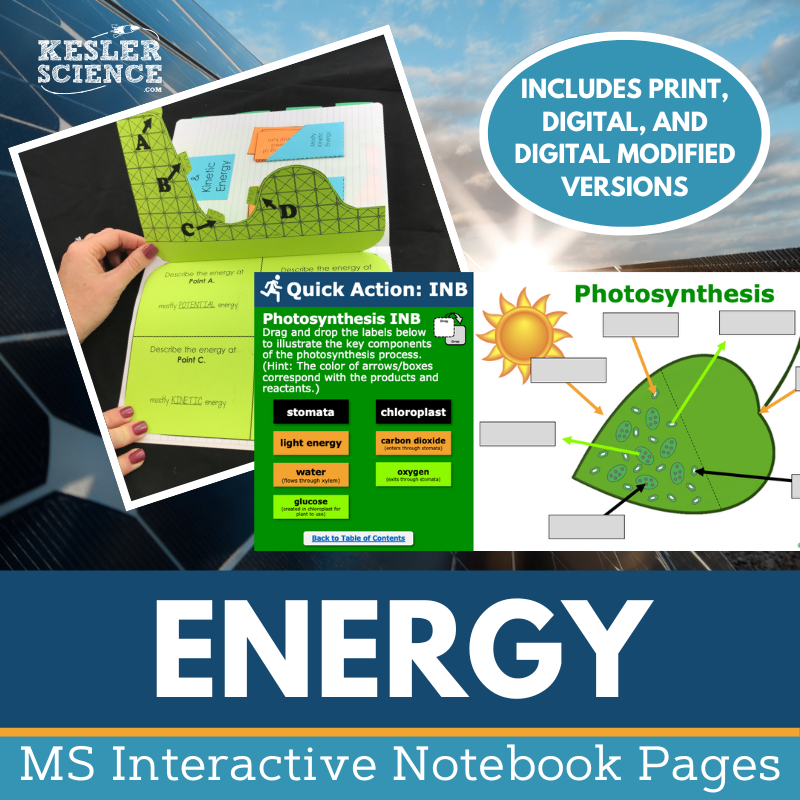Sound Waves Activities for Middle School Science
The Kesler Science Sound Waves resources provide a comprehensive, student-centered curriculum designed for middle school classrooms. The resources below will give students a comprehensive understanding of sound waves. All of the following materials are also included in the Kesler Science Membership.
The Kesler Science Sound Waves Complete 5E Lesson provides everything you need to teach an engaging, multi-day lesson on sound waves with minimal prep. This lesson allows for student-led learning, giving your junior high students the opportunity to explore key questions such as "What is sound?" and "How do sound waves travel?" while covering important concepts like the Doppler effect and how physical properties of a medium affect sound.
The lesson includes differentiated materials, multimodal learning options, and flexible formats for both printable and digital use. Editable PowerPoints and Spanish translations make it easy to customize the content for your classroom's needs. The 5E Model ensures a comprehensive approach through Engagement, Exploration, Explanation, Elaboration, and Evaluation stages, helping students master the topic.
With nine student-led stations, the Exploration phase offers a variety of interactive methods such as hands-on demos, readings, research, and videos. The Elaboration phase includes student-choice projects to extend learning, while the Evaluation phase provides updated assessments and review questions for further reinforcement.
The Kesler Science Sound Waves Complete 5E Lesson provides everything you need to teach an engaging, multi-day lesson on sound waves with minimal prep. This lesson allows for student-led learning, giving your junior high students the opportunity to explore key questions such as "What is sound?" and "How do sound waves travel?" while covering important concepts like the Doppler effect and how physical properties of a medium affect sound.
The lesson includes differentiated materials, multimodal learning options, and flexible formats for both printable and digital use. Editable PowerPoints and Spanish translations make it easy to customize the content for your classroom's needs. The 5E Model ensures a comprehensive approach through Engagement, Exploration, Explanation, Elaboration, and Evaluation stages, helping students master the topic.
With nine student-led stations, the Exploration phase offers a variety of interactive methods such as hands-on demos, readings, research, and videos. The Elaboration phase includes student-choice projects to extend learning, while the Evaluation phase provides updated assessments and review questions for further reinforcement.
The Kesler Science Sound Waves Station Lab is a modular, student-led activity designed to engage middle school students while teaching them about sound waves. The lab includes a variety of activities that help students explore how sound waves are reflected, absorbed, or transmitted through different materials, providing a hands-on and interactive learning experience.
This station lab is differentiated to accommodate various learning styles and needs. It consists of eight core stations and a bonus challenge station for early finishers. Students can complete the stations independently or in small groups, with the teacher facilitating rather than directing the learning.
The stations cover multiple learning formats, including hands-on activities, reading, research, video watching, and writing. From exploring sound waves through interactive demonstrations to creating models and responding to prompts, students are able to show their understanding in diverse ways. The stations are suitable for both in-person and virtual learning environments.
The Kesler Science Sound Waves Station Lab is a modular, student-led activity designed to engage middle school students while teaching them about sound waves. The lab includes a variety of activities that help students explore how sound waves are reflected, absorbed, or transmitted through different materials, providing a hands-on and interactive learning experience.
This station lab is differentiated to accommodate various learning styles and needs. It consists of eight core stations and a bonus challenge station for early finishers. Students can complete the stations independently or in small groups, with the teacher facilitating rather than directing the learning.
The stations cover multiple learning formats, including hands-on activities, reading, research, video watching, and writing. From exploring sound waves through interactive demonstrations to creating models and responding to prompts, students are able to show their understanding in diverse ways. The stations are suitable for both in-person and virtual learning environments.
The Kesler Science Sound Waves Student Choice Projects provide middle school students with the opportunity to choose how they demonstrate their understanding of sound waves. The project page offers six different options, plus a “design your own” choice, allowing students to take ownership of their learning.
With a flexible grading rubric, the projects can be assessed by teachers, peers, or the students themselves. Teachers can easily modify the rubric to meet their grading needs, ensuring it works for a variety of students. The projects include multimodal choices, catering to diverse learning styles and interests.
For differentiated learning, there are two versions of the project page. The modified version supports students needing remediation, while advanced learners can combine projects for added challenges. Many projects require just basic classroom materials, and several can be done digitally, making them easy to integrate into both traditional and virtual learning environments.
The Kesler Science Sound Waves Student Choice Projects provide middle school students with the opportunity to choose how they demonstrate their understanding of sound waves. The project page offers six different options, plus a “design your own” choice, allowing students to take ownership of their learning.
With a flexible grading rubric, the projects can be assessed by teachers, peers, or the students themselves. Teachers can easily modify the rubric to meet their grading needs, ensuring it works for a variety of students. The projects include multimodal choices, catering to diverse learning styles and interests.
For differentiated learning, there are two versions of the project page. The modified version supports students needing remediation, while advanced learners can combine projects for added challenges. Many projects require just basic classroom materials, and several can be done digitally, making them easy to integrate into both traditional and virtual learning environments.
The Kesler Science Energy Interactive Notebook Bundle offers an engaging way to teach energy concepts with both print and digital options. It’s perfect for traditional classrooms, 1:1 environments, or distance learning, providing flexibility for teachers and students alike.
Topics include conduction, convection, and radiation, energy transformations, renewable and nonrenewable resources, photosynthesis, potential and kinetic energy, and more. The digital version features a unique interactive notebook PowerPoint, compatibility with Google Slides, reflection pages, teacher answer keys, and a modified version for accommodations. The paper version includes blank templates, pre-filled templates for modified needs, and visual guides for assembly.
This bundle ensures students can actively participate in learning energy concepts while offering teachers versatile tools for instruction and assessment in any learning environment.
The Kesler Science Energy Interactive Notebook Bundle offers an engaging way to teach energy concepts with both print and digital options. It’s perfect for traditional classrooms, 1:1 environments, or distance learning, providing flexibility for teachers and students alike.
Topics include conduction, convection, and radiation, energy transformations, renewable and nonrenewable resources, photosynthesis, potential and kinetic energy, and more. The digital version features a unique interactive notebook PowerPoint, compatibility with Google Slides, reflection pages, teacher answer keys, and a modified version for accommodations. The paper version includes blank templates, pre-filled templates for modified needs, and visual guides for assembly.
This bundle ensures students can actively participate in learning energy concepts while offering teachers versatile tools for instruction and assessment in any learning environment.
Year-Round Resources
These year-round activities will increase your students' understanding of many middle school science topics. All of these activities are also included in the Kesler Science Membership.
Visual Data & Graphing
You're not alone if your students struggle with understanding graphs, charts, and tables. It's a skill that takes an enormous amount of practice. This resource will help students build a strong foundation in analyzing data and creating their own data visualizations.
Bell Ringers and Warm-Ups
These middle school science bell ringers are an excellent way to engage your students as soon as they walk into your classroom. This comprehensive FULL YEAR resource includes everything you need to start off each science class with an interesting warm-up activity.
Review Board Games
Each game board has been carefully designed to keep students engaged. There are 10 different action spaces on each board and dozens of question cards. All of the actions are related to science concepts and keep the students motivated throughout the game.
Each game is ready to play. Simply print out the board and the cards and let the students enjoy reviewing nine different units.
Essential Questions
Below are the essential questions associated with the lessons and activities included in this unit. This topic is only one of more than 100 middle school science topics included in the Kesler Science Membership.
-
What is sound?
-
How do sound waves travel?
-
How do physical properties of a medium affect the speed of sound waves?
-
What properties of waves affect what we hear?
-
What is the Doppler effect?
Kesler Science Membership
Imagine never having to search for another middle school science lesson again. The membership gives you access to ALL of the Kesler Science products in one place (Yes, including everything above).
Say goodbye to long hours of lesson prep.









